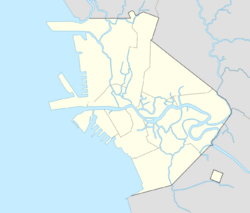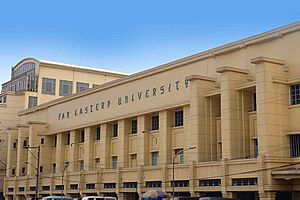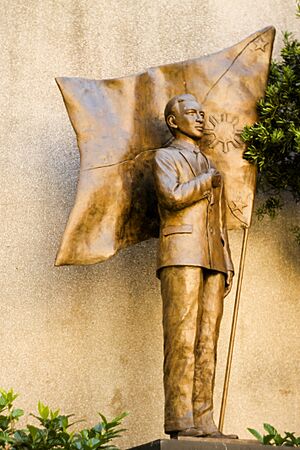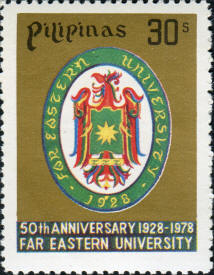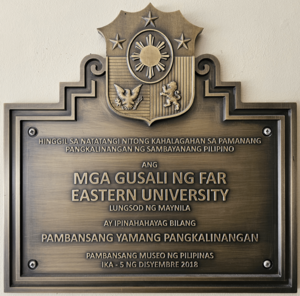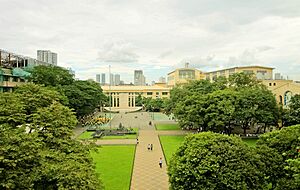Far Eastern University facts for kids
|
Pamantasan ng Malayong Silanganan (Filipino)
|
|
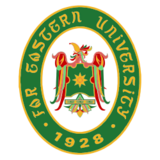
|
|
|
Former names
|
|
|---|---|
| Motto | "Be Brave" |
| Core Values | Fortitude, Excellence, and Uprightness |
| Type | Private university |
| Established | June 1, 1928 (97 years and 202 days) |
| Founder | Nicanor B. Reyes Sr. |
|
Academic affiliations
|
|
| Endowment | ₱4.1 billion (US$ 72 million) (2022) |
| Chairman | Aurelio Reyes Montinola III |
| President | Juan Miguel R. Montinola |
| Vice-president | Maria Teresa P. Tinio |
|
Academic staff
|
2,621 |
| Undergraduates | 39,361 including subsidiaries |
| Address |
Nicanor Reyes Street, Sampaloc, 1015
,
,
,
Philippines
14°36′14″N 120°59′08″E / 14.6038°N 120.9855°E |
| Campus | Main campus FEU Manila & FEU Tech 5 hectares (50,000 m2) Satellite campus FEU Makati 1.5 hectares (15,000 m2)
|
| Colors | Green Gold |
| Nickname | Tamaraws |
|
Sporting affiliations
|
|
| Mascot | TamTam and Sari |
Far Eastern University (Filipino: Pamantasan ng Malayong Silanganan), also known as FEU, is a private university in Manila, Philippines. It's a non-religious school that focuses on research. FEU was created in 1934 when Far Eastern College and the Institute of Accounts, Business and Finance joined together. Its first president was Nicanor Reyes Sr..
FEU started as the first school for accountancy in the Philippines. Over the years, it has grown to offer many different courses. These include arts, sciences, architecture, fine arts, education, engineering, computer studies, tourism, hotel management, law, nursing, and medicine. FEU has seven campuses in Metro Manila, Cavite, and Rizal. It offers programs from elementary school all the way to graduate studies.
The main FEU campus in Manila has several special institutes for different programs. Its accountancy program, along with other college programs, has received the highest Level IV accreditation. This means it meets very high standards. The Commission on Higher Education (CHED) also recognizes FEU as a top school for Business Administration and Teacher Education.
FEU's campus is famous for its beautiful Art Deco buildings. These buildings were built in the early 1900s and are still well-preserved. FEU is ranked among the top universities in the Philippines and Southeast Asia.
Contents
- History of FEU
- University Emblems
- Manila Campus
- Campus Building History
- Heritage Buildings of FEU Manila Campus
- Nicanor Reyes Sr. Hall
- Administration Building
- Admissions Building
- Architecture and Fine Arts Building
- Science Building
- Accounts, Business and Finance Building
- Alfredo Reyes Hall
- Arts Building
- Education Building
- Engineering Building
- FEUTURE Center
- Nursing Building
- FEU Auditorium
- FEU Chapel
- Dr. Nicanor Reyes Sr. Memorial Square
- FEU Library
- Academics
- Student Life
- FEU Group of Schools
- Notable Alumni
- See also
History of FEU
How it Started
Far Eastern University was founded in November 1933. It was formed by combining two schools: Far Eastern College and the Institute of Accounts, Business and Finance (IABF). Far Eastern College began in 1919 and focused on liberal arts. The IABF was started in 1928 by Francisco Dalupan Sr. and Nicanor Reyes Sr., who was a professor at the University of the Philippines.
FEU started with only 117 students. Before World War II, it grew to 11,000 students! The university showed that a private school could be successful in the Philippines. FEU is the 6th oldest university in the Philippines and the 4th oldest private, non-religious university.
In the early 1930s, FEU was in an old tobacco factory. Later, a new, bigger campus was built. This new campus was designed by Architect Pablo Antonio Sr., a famous artist in architecture.
In 1934, FEU created its first four main departments: Accounts, Business and Finance, Arts and Sciences, Law, and Education. Two years later, the Institute of Technology was also added.
Dr. Reyes Sr., the first president, worked hard to set up the courses and programs. He asked Architect Pablo S. Antonio Sr. to design the main buildings. In 1940, the Nicanor B. Reyes Sr. Hall opened. It housed the main library and the business department. Two other buildings for high school students were also built. By then, FEU had about 10,000 students, including 400 from other countries. Former Philippine President Manuel L. Quezon even called FEU "the best non-religious institution in the country."
In 1941, FEU also had the first ROTC (Reserve Officers' Training Corps) units for quartermasters and finance in the Philippines. During World War II, many FEU cadets fought bravely in Bataan.
During World War II
In 1942, the university closed because of the war. The Japanese Army used the campus for transportation and as a prisoner-of-war office.
During the Battle of Manila in 1945, Dr. Reyes Sr. was killed. After the war, the university reopened in June 1945. Hermenegildo B. Reyes became the second president.
After the War
FEU reopened in October 1945, even though American forces still used some of its buildings until May 1946. After the war, FEU grew a lot. It added many new facilities to meet the needs of more students. In the early 1950s, FEU was even called the "Largest University in Asia" with nearly 50,000 students!
FEU continued to expand. It opened the Science Building and started the Institute of Medicine and the School of Nursing. In 1955, the FEU Hospital opened. In 1970, the Institute of Architecture and Fine Arts was established. Also in 1970, the medical and nursing parts of FEU became a non-profit foundation called the Far Eastern University – Nicanor Reyes Medical Foundation.
In 1989, Nicanor Reyes Jr. started a big project to improve FEU. Buildings were renovated, and the quality of education was raised. This led to many programs getting special accreditation. The university also improved its auditorium for performances and started publishing scholarly journals.
In 1996, FEU decided to focus on computer technology. It phased out its engineering programs and partnered with East Asia Computer Center, Inc. Later, in 2003, FEU bought out its partner and created the FEU East Asia College (FEU-EAC).
In 2010, FEU opened the Institute of Tourism and Hotel Management and a new campus in Makati. The Makati campus offered programs in Accountancy, Information Technology, and Business Administration. FEU also opened campuses in Silang, Cavite, and Filinvest City in Alabang. It also acquired Roosevelt College, Inc. in Rizal.
In 2022, the new Institute of Health Sciences and Nursing (IHSN) was created. It combined the existing Nursing program with Medical Technology and other health programs.
In 2024, FEU brought back its Chemistry and Economics programs. It also launched three new programs: Human Resource and Organizational Development, Pharmacy, and Nutrition and Dietetics.
FEU as a Company
Far Eastern University, Incorporated (FEU) is a private educational institution. It was officially registered as a company in October 1933. In 1986, it became a listed company on the Philippine Stock Exchange.
The company manages education, real estate, and investments. It has locations in Manila, Makati, and Cavite.
FEU has several important schools under its group. These include Far Eastern College – Silang, Inc. (FECSI), East Asia Computer Center, Inc. (EACCI), FEU Alabang, Inc., and FEU High School, Inc. In 2016, FEU also acquired a large part of Roosevelt College, Inc.
In 2019, FEU partnered with the Technological Institute of the Philippines to open Edustria, a senior high school in Batangas.
In 2022, FEU made two more partnerships. One was to set up a nursing school in Brunei. The other was with Good Samaritan Colleges in Cabanatuan City, Nueva Ecija.
University Emblems
The University Seal
The FEU Coat of Arms shows a Sarimanok holding a kalasag (a shield). Inside the kalasag is an 8-pointed star with a bamboo scroll. On the scroll are the old Filipino letters “KKK”. The university seal has this Coat of Arms inside a green oval with a gold outline. Around it is the university's name in a special font and the founding year of IABF.
- The logo and font were designed by Galo Ocampo, who is known as the Father of Philippine Heraldry.
- FEU was one of the first universities in the Philippines started by a Filipino. In 1961, the university chose the Sarimanok design to show its nationalistic spirit.
- The "KKK" stands for Katotohanan (Truth), Kagandahan (Beauty), and Kabutihan (Goodness).
The University Colors
Green and Gold are FEU's official colors. Green stands for hope, like Rizal's idea of the youth as the "Fair hope of the Fatherland." Gold represents the great chance for the university to help young people and for its graduates to serve the country.
The University Mascot
The tamaraw is FEU's athletic mascot and the nickname for every FEU student. This animal, scientifically called “Bubalus mindorensis,” is found only on the island of Mindoro. The tamaraw is known for being intelligent, strong, and brave. This symbolizes how the university is advanced and progressive in education.
The University Mace
The mace is a special symbol of the University. It is used in formal events like graduation ceremonies. The mace represents the President's Office. It has the University seal made of solid bronze on top of a staff made from Philippine hardwood.
Manila Campus
FEU's campus has five buildings designed by the famous architect Pablo S. Antonio Sr. In 2005, United Nations Educational, Scientific and Cultural Organization (UNESCO) gave FEU an award for keeping these Art Deco buildings so well preserved. These buildings include the Nicanor B. Reyes Sr. Hall, the Admissions Building, the Architecture and Fine Arts Building, the Administration Building, and the Science Building. The Cultural Center of the Philippines also recognized these historic buildings. Other important buildings are the 1950s FEU Chapel and the Arts Building, designed in the International Style.
In 2018, these Art Deco buildings, the FEU Chapel, and several artworks were declared National Cultural Treasures by the National Museum of the Philippines. The chapel has a mosaic by Vicente Manansala and paintings by Botong Francisco. Stained-glass panels and a mural by Antonio Dumlao were also recognized. Brass sculptures by Manansala and bas-reliefs by Francesco Riccardo Monti are also National Cultural Treasures.
The university has many modern facilities. These include an electronic library, different types of laboratories, an auditorium, and multimedia rooms. It also has a special gate security system and gymnasiums. FEU is known for its green and eco-friendly campus. It is often called the "Oasis of the University Belt" because of its beautiful environment.
| Presidents | |
|---|---|
| Name | Years in Office |
|
|
|
| Nicanor B. Reyes Sr. | 1934–1945 |
| Hermenegildo T. Reyes | 1945–1946 |
| Clemente Q. Uson | 1946–1949 |
| Vidal A. Tan | 1949–1952 |
| Teodoro T. Evangelista Sr. | 1952–1971 |
| Nicanor M. Reyes Jr. | 1971–1985 |
| Josephine C. Reyes | 1985–1989 |
| Felixberto C. Sta. Maria | 1989–1995 |
| Edilberto de Jesus | 1995–2002 |
| Lydia B. Echauz | 2002–2012 |
| Michael M. Alba | 2012–2023 |
| Juan Miguel R. Montinola | 2023–present |
| References | |
Campus Building History
In the 1930s, American culture greatly influenced building design in the Philippines. Concrete and steel were popular materials. Architect Pablo S. Antonio Sr. used these materials to create FEU's campus buildings. His designs showed a mix of Art Deco and the International Style. The buildings were constructed between 1939 and 1950.
Heritage Buildings of FEU Manila Campus
Nicanor Reyes Sr. Hall
The Nicanor Reyes Sr. Hall is named after the university's founder. It's a long, U-shaped building facing Quezon Boulevard. This building was constructed in 1940 by National Artist Arch. Pablo Antonio Sr. It has unique vertical sections on both ends.
The building shows the strong influence of Art Deco in its design. Even the stairs have special details, with thin concrete slabs that curve like waves. The building's overall look is a great example of classic Philippine Art Deco, playing with geometric shapes.
The Nicanor Reyes Sr. Hall houses the university library and many academic offices.
Administration Building
The Administration Building was also designed by Arch. Antonio Sr. It was built about ten years after the Nicanor Reyes Hall. It stands across the campus quadrangle. Its front has geometric details, horizontal windows, and a balcony for viewing activities in the quadrangle.
This building displays works by many famous Filipino artists from the Art Deco period. A mural by Antonio Gonzales Dumlao shows the university's goals. Italian sculptor Francesco Riccardo Monti created a bas-relief in the lobby, showing Philippine history. The Art Deco FEU Auditorium is also inside this building.
The Auditorium has many Art Deco features, like curves, ribbed pillars, and geometric patterns. Its interior was restored in 2002-2003. It was the only post-war venue with air-conditioning and a revolving stage. In the 1950s, it was a major cultural center in the Philippines.
Admissions Building
The Admissions Building opened in 1940. It looks like a mirror image of the Architecture & Fine Arts Building. It was first used as the Girls' High School. Later, it housed the Institute of Medicine. In the early 2000s, it became the main building for FEU-East Asia College. In 2015, it was renovated and renamed the Admissions Building. Today, it holds offices for student admissions, financial aid, and alumni relations.
Architecture and Fine Arts Building
This building is one of two buildings that stand on either side of the Administration Building. It was designed by Arch. Antonio Sr. in the Art Deco Style and built in 1941. It used to be the Boys' High School. It also housed the Law and Nursing programs before becoming home to the Institute of Architecture and Fine Arts.
Science Building
The Science Building, with seven stories, was built in 1950. It was the last building designed by Arch. Antonio Sr. and shows a mix of Art Deco and the International Style. In 1990, an earthquake damaged the building, so the top two floors were removed. In late 2013, a sixth floor was added. This building has many science laboratories for Biology, Nursing, Medical Technology, and Pharmacy programs.
Accounts, Business and Finance Building
This 7-story building was originally an expansion of the Nursing Building in the early 1970s. It was known as the Education Building. In 2017, it was renamed the Accounts, Business and Finance Building. It is now used by the Institute of Accounts, Business and Finance.
Alfredo Reyes Hall
The Alfredo Reyes Hall is named after one of the founder's sons. It's a 6-story building next to the Nicanor Reyes Hall. It houses the Institute of Tourism and Hotel Management. It has a practice hotel, cooking labs, and a basketball court with special maple wood flooring. It also has a student-run café called Cafe Alfredo, which opened in 2014.
Arts Building
Designed by Felipe Mendoza, the Arts Building was built in 1960. It was originally 7 stories tall but was reduced to 4 stories after the August 1968 Luzon earthquake. The Arts Building is home to the Institute of Arts and Sciences' departments like Communication, Political Science, and Psychology. It has a gym on the top floor and a conference center on the ground floor.
Education Building
This seven-story building was finished in 2001 as part of FEU-EAC's expansion. Its design is similar to the Nicanor Reyes Hall, with two pillars and an arched green glass rooftop. The building now houses the Institute of Education.
Engineering Building
This nine-story building stands where the old FEU Hospital used to be. After the hospital moved, the old structure was taken down, and this new building was completed in 2005. It was designed by Arch. Pablo Antonio, Jr. and was called the Technology Building. In 2019, it was renamed the Engineering Building. It has the FEU Tech Innovation Center, a small auditorium, and the FEU Center for the Arts.
FEUTURE Center
The FEU Transformative University Resource Center, or FEUTURE Center, is the newest building at the university. It's an 8-story building on Lerma Street. It has more classrooms, learning facilities, and parking spaces. Construction started in 2018 and it opened in April 2021.
Nursing Building
This seven-story building was completed in the 1960s. It used to house the Institute of Architecture and Fine Arts. Later, it was given to the Institute of Nursing, which is why it has its current name. Today, it still has the Institute's Virtual Integrated Nursing Education Simulation Laboratory (VINES) and is mostly used by FEU High School.
FEU Auditorium
The FEU Auditorium was designed by Pablo Antonio Sr., a National Artist for Architecture, in 1949. It was known as the first "cultural center of the Philippines" and the very first fully air-conditioned auditorium in the country. It can hold 1100 people. The Auditorium was home to the Manila Symphony Orchestra for nine years. Many famous Filipino and international performers have performed there. It also hosted major plays. Today, the Auditorium continues to host notable performances.
FEU Chapel
Inside the campus is the Student Council Association (SCA) Chapel, also designed by Arch. Mendoza. It opened on December 8, 1957. Catholic activities for staff and students are held here. Inside, there are paintings by Carlos “Botong” Francisco, a National Artist for Visual Arts. His paintings include the 14 Stations of the Cross and the Crucifixion. The front of the chapel has a colorful tile mosaic of Our Lady of Fatima by Vicente Manansala.
Dr. Nicanor Reyes Sr. Memorial Square
In the center of the campus is this striking landmark. It was built to celebrate the University's 40th anniversary. It has a 65-foot flagpole on a platform. Around the platform are brass sculptures by Manansala, which show the founder's ideas about education.
FEU Library
The FEU Library is on the second and third floors of the Nicanor Reyes Hall. It has a large collection of books, including reference books and Filipino works. Students can easily find books using the Online Public Access Catalog (OPAC), which is an online database. The Electronic Library also provides online learning resources.
In 2012, the Philippine Association of Academic Research Librarians, Inc. (PAARL) gave the FEU library an award for its excellent contribution to academic and research librarianship.
Academics
Far Eastern University offers many different programs. It has 28 college programs and 21 graduate programs. It also has a law school. FEU Tech offers 9 college programs in engineering and computer studies. The university also has high school and other certification courses. Since 2020, FEU Manila has also offered programs at its Cavite campus.
The university uses a semester system. An academic year starts in the second week of August and ends in May. A Board of Trustees, made up of experts in different fields, oversees the university.
| Institute Founding | |
|---|---|
| Institutes | Year Founded |
|
|
|
| Accounts, Business and Finance | 1929 |
| Arts and Sciences | 1934 |
| Education | 1934 |
| Law | 1934 |
| Technology | 1936 |
| Medicine | 1952 |
| Nursing | 1955 |
| Graduate Studies | 1957 |
| Architecture and Fine Arts | 1970 |
| Tourism and Hotel Management | 2010 |
| Health Sciences and Nursing | 2022 |
The FEU General Education (GE) program includes fifteen 3-unit courses, usually taken in the first two years of college. This program helps students develop important knowledge and skills. It focuses on critical thinking and understanding how different subjects connect. The GE courses encourage students to learn actively.
Admissions and Scholarships
Students who want to study at FEU usually need to pass the College Entrance Exam (FEUCAT).
In 2021, because of the COVID-19 pandemic, the FEUCAT was replaced by the FEU Student Placement for Admission to College Education (SPACE). This system used academic performance from Grades 11 and 12 for admissions. The FEUCAT exam returned in 2022.
FEU has an open admission policy, which means it welcomes many different students without very strict entrance exams. This helps more people get a college education. However, some specific programs might have extra requirements.
FEU helps over 3,500 students with scholarships every year. This means about 11% of all students receive financial help. Scholarships are given to students who do well in school, those who need financial help, and students who represent the university in sports or other activities.
Grading System
A student's final grade at FEU is usually a letter. This letter shows how well they did in their assignments and tests. An "A" is worth 4 points, "B+" is 3.5, "B" is 3, "C+" is 2.5, "C" is 2, "D+" is 1.5, "D" is 1, and "F" is 0. To pass any course at FEU, a student needs at least 50%.
| University rankings | |
|---|---|
| Regional – Overall | |
| QS Asia | 701-705 (2024) |
| National – Overall | |
| QS National | 11 (2024) |
Recognition and Accreditation
FEU Manila has been given "Autonomous University" status by the Commission on Higher Education (CHED). This means it meets the highest standards for universities in the Philippines. CHED has also named FEU's Teacher Education Program as a "Center of Excellence" and its Business Administration program as a "Center of Development."
The university has twenty-one accredited programs. Eight of its college programs have the highest Level IV accreditation from the Philippine Association of Colleges and Universities Commission on Accreditation (PACUCOA). The other programs are working towards higher accreditation levels.
FEU Manila is also recognized internationally. It is a member of the ASEAN University Network – Quality Assurance (AUN-QA). It is also part of the Association to Advance Collegiate Schools of Business (AACSB) for its Accountancy, Business Administration, and Master of Business Administration programs. FEU Manila has accreditation for 16 programs from AUN-QA. Its Tourism Management program is also recognized as a Center of Excellence by the Asia-Pacific Institute for Events Management (APIEM).
FEU was the only Philippine school in the World Universities with Real Impact (WURI) Ranking for 2020. It ranked 91st among the Global Top 100 Innovative Universities. It also placed 19th for Ethical Value. FEU has also joined the Quacquarelli Symonds (QS) Rankings (2025), ranking 681-700 in Asia.
International Recognition
The university received an ISO 9000:2008 for Quality Management. FEU is actively building connections with 30 international institutions.
- Associate Member of the ASEAN University Network Quality Assurance
- Member of the Association of the Universities of Asia and the Pacific
- Center for Excellence by the Asia Pacific Institute for Events Management International
- Accredited by the Association of Chartered Certified Accountants
- Member of the Association to Advance Collegiate Schools of Business
- Associate Status with the International Centre of Excellence in Tourism and Hospitality Education
- Member of the Pacific Asia Travel Association
Local Recognition
FEU has twenty-one accredited programs by the Philippine Association of Colleges and Universities Commission on Accreditation (PACUCOA) and Philippine Accrediting Association of Schools, Colleges and Universities (PAASCU).
- PACUCOA Level IV Accredited programs: Accountancy, Applied Mathematics with Information Technology, Biology, Business Administration, Communication, Elementary Education, Secondary Education, Psychology
- PACUCOA Level III Accredited programs: Hotel and Restaurant Management, Tourism Management, Language and Literature Studies, Political Science, International Studies, Doctor of Education, Master of Arts in Education, and Master of Arts in Psychology
- PACUCOA Level II Accredited programs: Architecture, Fine Arts major in visual Communication/Studio Arts, Medical Technology
- PACUCOA Level I Accredited programs: Master of Science in Biology and Master of Arts in Communication
- PAASCU Level III Accredited program: Bachelor of Science in Nursing
- Founding member of Philippine Association of Colleges and Universities (PACU)
Research at FEU
FEU supports research in many areas. These include studying different kinds of plants and animals (biodiversity), improving city environments (urban renewal), public health, genetics, language studies (sociolinguistics), and local cultures. FEU works with other universities and groups to do research. These partnerships often involve student and teacher exchange programs and joint research projects.
- University Research Center (URC) - This center helps promote research at the university. It provides funding, training, and helps share research information.
- FEU Public Policy Center - This group does research to help create better government policies.
- Center for Studies on the Urban Environment (SURE) - This center was created to help improve city environments.
- FEU Academy (Center for Continuing Education) - This part of the university offers training programs for people who are not FEU students.
- FEU Tech Innovation Center - This center helps develop new business ideas.
- FEU Community Extension Services (CES) - This group helps the community.
- Center for Teaching and Learning (CTL)
- Center for Learning Enrichment and Research for Students (CLEARS)
- Language Learning Center
Publications
FEU publishes various important materials, journals, and university publications.
- Annual Report
- President's Report
- TAMBULI - the official publication of Far Eastern University.
- The FEU Advocate - the official student newspaper of FEU Manila, started in 1934.
- Asian Journal on Perspectives in Education - an open, international journal.
- FRAMEwork: The Asia-Pacific Journal of Communication - an academic journal.
- Urban Review Asia
- Sikhay - the graduate studies journal.
- Cocoon Philippines - a project between FEU and the University of Queensland.
- The Paragon - the official student publication of IAS, started in 2006.
- Circle Arts and Design Magazine - the official publication of IARFA, showing student art projects.
- The Lamp - the official student publication of IN.
- ACONS - a publication of the IHSN and FEU Nursing Alumni Foundation, USA.
- Far Eastern Law Review - the official journal of IL.
Student Life
FEU has a long and rich history in education, culture, arts, sports, and developing student leaders.
Athletics
FEU is a founding member of two major college sports organizations in the Philippines: the National Collegiate Athletic Association (NCAA) and the University Athletic Association of the Philippines (UAAP).
Many famous athletes have attended FEU, including Lydia De Vega and Johnny Abarrientos. FEU's sports teams are called the Tamaraws, named after the fierce buffalo.
FEU holds the record for the most championships in men's basketball, with 20 titles. FEU is also second overall in combined championships across all basketball divisions (juniors, women's, and men's). The Tamaraw Spikers have the longest championship streak in the UAAP volleyball. FEU also leads in UAAP track and field, with an impressive 57 titles.
Events
Tatak Tamaraw - a week-long event that welcomes new students to FEU. It helps them learn about school rules and campus life.
Tam Hunt - a fair where students can join different school organizations.
Tam Rally - a parade and performances by FEU Athletes and Cultural Groups before the UAAP season starts.
CreePIYU - an annual Halloween event organized by the FEU Guides.
Pasko sa Piyu - a university-wide Christmas celebration that ends with lighting the Christmas Tree. It features performances from cultural groups.
One Concierto Piyu - a concert held on the last day of the university's foundation week.
Arts and Culture
Since 1990, FEU has had the FEU Center for the Arts (FCA). This center plans cultural activities all year round. The FCA supports seven cultural groups, including the FEU Bamboo Band, FEU Chorale, FEU Dance Company, and FEU Theater Guild. The FEU Guides give tours of FEU's UNESCO-recognized campus.
FEU has a large art collection. It includes works by famous Filipino artists like National Artists Botong Francisco and Vicente Manansala. These artworks are displayed throughout the university's campuses and buildings. Memorabilia of National Artist for Literature Nick Joaquin is also on display at the FEU library.
FEU was the first university in the Philippines to allow students to dress according to their gender identity. In August 2016, the university relaxed its dress code. It now has all-gender restrooms, no strict haircut policy, and allows school attire options instead of a uniform. It also has a multi-faith room.
Student Organizations
There are over 60 student organizations at FEU. These groups offer students experiences outside the classroom to help them grow. They usually hold projects during special activity periods.
The FEU Central Student Organization is the main student government. It works to protect student rights and well-being. It also creates programs and activities for students inside and outside the university.
FEU Group of Schools
The FEU Group of Schools is a network of schools in the Philippines. They offer many different programs for various levels of education. The group has six legal parts operating ten campuses for over 40,000 students.
- Far Eastern University (FEU Manila), the main and oldest campus, is in Sampaloc, Manila. It has many academic programs and research centers. It also serves as the main office for the entire FEU Group of Schools.
- FEU Makati is a campus in the center of Makati's business district. It mainly serves graduate students studying business and law.
- FEU Institute of Technology (FEU Tech), located near the main campus in Sampaloc, Manila, focuses on engineering and technology. It offers programs in Engineering and Computer Studies.
- FEU Diliman, in Diliman, Quezon City, is the largest FEU campus. It offers programs from kindergarten to high school, and college programs in Accounts, Business, and Computer Studies. FEU Diliman also has the FEU Sports Center.
- FEU Alabang is an extension campus of FEU Tech in Muntinlupa. It offers college programs in engineering, business, and computer studies, along with Senior High School options.
- FEU Roosevelt is a private, non-religious college system with campuses in Cainta, Marikina, and Rodriguez. It offers basic education and various college programs, including teacher education.
- FEU Cavite, in Cavite, is an extension campus of FEU Manila. It offers complete educational programs from elementary to senior high school and various college programs.
- FEU High School, a separate school from the university, offers junior and senior high school programs. It has different academic tracks like STEM, ABM, HUMSS, and GAS.
- Far Eastern University – Nicanor Reyes Medical Foundation (FEU-NRMF), in Quezon City, is the medical campus. It operates on its own but is still part of the FEU network. FEU NRMF offers many healthcare programs, including Medicine, Nursing, Pharmacy, and Physical Therapy. It also has a Senior High School program focused on STEM.
- FEU Pampanga, formerly Colegio de Sebastian-Pampanga, is the newest addition to the FEU Group. It was acquired in 2023 and is set to open in July 2025. It will offer secondary to college education programs.
Notable Alumni
Since it started in 1928, FEU has produced many successful people. These include national artists, award winners, business leaders, ambassadors, Supreme Court justices, doctors, nurses, teachers, and media personalities.
Famous people like former Supreme Court Chief Justice Artemio Panganiban, business leaders Henry Sy (SM Investments), Lucio Tan (Fortune Tobacco and Philippine Airlines), and Ramon Ang (President of San Miguel Corporation) have all been connected to FEU.
National Artist for Literature Alejandro Roces is an alumnus and former dean. A lecture series is held every year at FEU in his honor.
FEU has also produced many great athletes. These include Anthony Villanueva (boxing), Lydia de Vega (track and field), Johnny Abarrientos (basketball), and Janelle Mae Frayna (chess). They have all represented the university with pride.
See also
- List of colleges and universities in Metro Manila


